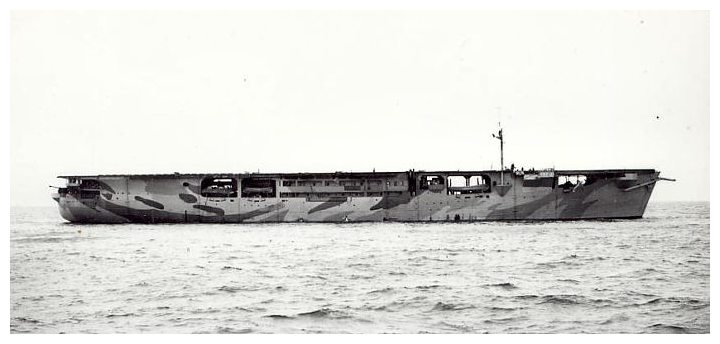The following article on the HMS Audacity is an excerpt from Barrett Tillman’s book On Wave and Wing: The 100 Year Quest to Perfect the Aircraft Carrier. It is available to order now at Amazon and Barnes & Noble.
Probably no warship had a more varied career in the Second World War than HMS Audacity. Launched in March 1939 as the German cargo liner Hannover, she was intercepted in the West Indies in March 1940. Overtaken by Royal Navy warships, her crew tried to scuttle, but the British took her under tow to Jamaica. After repairs she entered British service as Sinbad, registered in Kingston, Jamaica. The admiralty saw other uses for a twelve thousand-ton, 440-foot ship, however, and in November renamed her Empire Audacity, one of seventeen “ocean boarding vessels” largely devoted to enforcing blockades.
While laid up at Blyth, the German-built vessel underwent another conversion, this time into the first escort aircraft carrier. When she emerged in June 1941 she bore yet another name, as the admiralty preferred simply HMS Audacity. She was a rudimentary carrier with no hangar deck, meaning her few aircraft had to be stored and maintained on the flight deck despite weather conditions.
Traditionally superstitious, sailors have long held that it’s bad luck to rename a ship. That certainly applied to HMS Audacity, which deployed under her fourth name. She embarked eight Grumman Martlets—Royal Navy versions of the F4F Wildcat—on her first convoy escort in September 1941. The fighters were intended to protect ships from air attack, but on convoy OG 74 from the United Kingdom to Gibraltar, Focke-Wulf 200 Condor bombers sank one ship while U-boats destroyed four more.
Then in late October, protecting OG 76 to Gibraltar, HMS Audacity’s fighters downed four Condors, a record. One Martlet fell to the FW’s heavy return fire, but Sub-Lieutenant Eric “Winkle” Brown became the champion Condor killer with two victories on the cruise. Thereafter HMS Audacity was marked for destruction by the U-boat command.
HG 76 left Gibraltar on December 14, with HMS Audacity embarking just four Grummans, supported by three destroyers. The convoy drew a U-boat wolfpack while Audacity’s planes downed two more Condors but lost one in an attack on a surfaced submarine. U-131 was damaged and scuttled.
More action came the night of December 21. Ten U-boats stalked the convoy, four actually attacking. Silhouetted under flares, Audacity appeared in the periscope of U-751’s Kapitänleutnant Gerhard Bigalk, a former merchant officer. In two approaches he put three torpedoes into her, igniting aviation gasoline and severing her bow. Sub-Lieutenant Brown, later the world champion carrier aviator, had just moments to order his priorities. Given a choice between saving pajamas recently purchased for his fiancée or his logbook, he did what any pilot would do—he wrapped up his log and abandoned ship.
The HMS Audacity sank in little more than an hour.
Additionally, the convoy lost two merchantmen and an escort while Admiral Doenitz wrote off three boats. It was a lesson for both sides in attrition warfare at sea.
Sinking the HMS Audacity
Kapitänleutnant Gerhard Bigalk logged his approach and attack on HMS Audacity the night of December 21, 1941:
Very dark night, overcast . . . moderate swell. . . . Spread of four, enemy speed 10 knots, inclination 80°, bows left, depth 3 m, range 1,200 m. After running time of 3 min. 20 sec. we see a detonation against the stern of the enemy— this also turned out to be clearly audible in the forward compartment.
Enemy alters course away from us to port. The light produced by some extremely bright starshell reveals her beyond all doubt to be an aircraft carrier. Now I understand why I got her range and speed so wrong.
I withdraw somewhat to reload torpedoes, keeping a close watch on the carrier. . . . After her course alteration to port (south) the carrier slows to a halt. . . . The first torpedo hit must have shattered her rudder and propellers because carrier seems powerless to manoeuvre [sic] herself out of an unfavorable position beam to wind. [Actually her engine room was flooding.] With just a single torpedo—all that remains loaded in my stern tube—there’s little chance of my sinking her. I’ll have to wait until at least two bow tubes have been reloaded. . . .
The shadow is so monstrously large that its breadth covers at least two periscope glass widths. Line of bearing 0°, range 800 m, enemy speed=0. Running time 50 sec, depth 4.5 m. Twin salvo from Tubes I and III. Tube I hits 25 m from the stern. Tube III 10 m forward of midships. Shortly after these hit there is a third powerful detonation accompanied by flames and a substantial quantity of smoke. . . . Carrier is firing red distress signals. Two destroyers approach at high speed. As one of them heads straight towards me I am forced to withdraw.
Bigalk and his submarine were lost to British bombers in July 1942.
 |
This article on HMS Audacity is an excerpt from Barrett Tillman’s book On Wave and Wing: The 100 Year Quest to Perfect the Aircraft Carrier. It is available to order now at Amazon and Barnes & Noble.
You can also buy the book by clicking on the buttons to the left.
This article is part of our larger resource on the WW2 Navies warfare. Click here for our comprehensive article on the WW2 Navies.
Cite This Article
"HMS Audacity: The Royal Navy’s Jack-of-all-Ships" History on the Net© 2000-2024, Salem Media.
April 26, 2024 <https://www.historyonthenet.com/hms-audacity>
More Citation Information.







